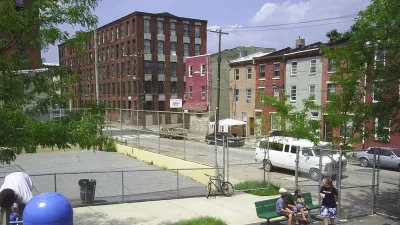Just after 2008 began, I realized my profession of choice was dying. I’d spent the previous seven years at Philadelphia Weekly, a fairly typical alternative newspaper: you know, magazine-style lefty bent, where-to-go-and-what-to-do listings, porn ads in the back. The usual.
Just after 2008 began, I realized my profession of choice was dying.
I'd spent the previous seven years at Philadelphia Weekly, a fairly typical alternative newspaper: you know, magazine-style lefty bent, where-to-go-and-what-to-do listings, porn ads in the back. The usual.
I'd worked primarily as an editor, but covered a wide range of topics as a writer--some more planning-related than others. Our page counts--a good indicator of any paper's fiscal health--fluctuated with the economy, and we'd known print journalism was in trouble for a while. (Thanks, Internet! Especially you, blogs!) But the bottom seemed to fall out pretty suddenly. When our page counts tanked just after the new year, it occurred to me I should maybe have a plan B.
A week and a half later, I was taking the GRE.
At the paper, I was always the guy suggesting story ideas like, "How about if we pick six vacant architectural treasures along Broad Street and write how they could best be brought back to life?" (My editor repeatedly passed on that story; I still maintain it would be a winner.) But it wasn't until the last year or two that I realized the topics that excited me most as a writer had not only a name, but a field and profession.
And so next week is the official start of my master's program in city planning at the University of Pennsylvania.
I've long been married to Philadelphia, and I knew Penn well from my days as an undergrad, so the school selection was a no-brainer. The program, they told us, was supremely focused on coming up with real-world solutions to actual problems.
So instead of just writing about the problems of the city I love, I get to actually solve them? Perfect.
Luckily, an old mentor was able to take my vague description of my interests ("I really like figuring out the best way urban spaces can be used") and define it as a concentration ("So you want to do urban design"). Once the tuition deposit was in, it was just a matter of teaching myself statistics over the summer (because Penn said so), reading whatever Jane Jacobs chapters I'd missed as an undergrad (because I said so), and quitting my job. My classmates' summers were pretty similar.
We're just finishing up our two-week "bootcamp," in which we had statistics review, learned spreadsheet modeling, got a crash course in a mess of graphics applications, and learned basic sketching, drafting and planning techniques in an introduction to urban design. It's been a good baptism by fire, and just a hint of the lack of sleep and free time we can look forward to over the next two years. The material looks challenging, time-consuming, and, well, kind of awesome.
The biggest debate in newspaper circles these days is how long--10 years? 15?--the print product will continue to exist as we know it. On the flipside, one of the intro articles Penn gave us was my academic advisor Jonathan Barnett's "Smart Growth in a Changing World," in which he says the number of urbanized counties in the U.S. will nearly double by 2050, from 444 to 797.
Which profession would you choose?

Alabama: Trump Terminates Settlements for Black Communities Harmed By Raw Sewage
Trump deemed the landmark civil rights agreement “illegal DEI and environmental justice policy.”

Study: Maui’s Plan to Convert Vacation Rentals to Long-Term Housing Could Cause Nearly $1 Billion Economic Loss
The plan would reduce visitor accommodation by 25% resulting in 1,900 jobs lost.

Planetizen Federal Action Tracker
A weekly monitor of how Trump’s orders and actions are impacting planners and planning in America.

Parklet Symposium Highlights the Success of Shared Spaces
Parklets got a boost during the Covid-19 pandemic, when the concept was translated to outdoor dining programs that offered restaurants a lifeline during the shutdown.

Federal Homelessness Agency Places Entire Staff on Leave
The U.S. Interagency Council on Homelessness is the only federal agency dedicated to preventing and ending homelessness.

Restoring Northern India’s Himalayan ‘Water Temples’
Thousands of centuries-old buildings protect the region’s natural springs and serve as community wells and gathering places.
Urban Design for Planners 1: Software Tools
This six-course series explores essential urban design concepts using open source software and equips planners with the tools they need to participate fully in the urban design process.
Planning for Universal Design
Learn the tools for implementing Universal Design in planning regulations.
Caltrans
Smith Gee Studio
Institute for Housing and Urban Development Studies (IHS)
City of Grandview
Harvard GSD Executive Education
Toledo-Lucas County Plan Commissions
Salt Lake City
NYU Wagner Graduate School of Public Service




























